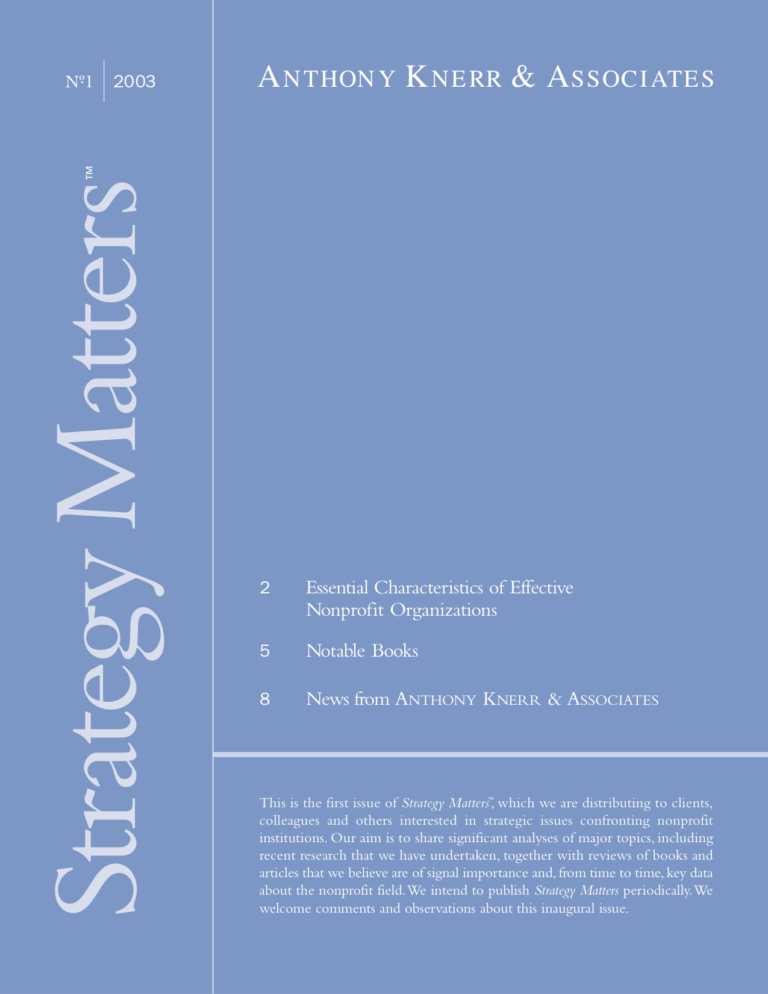Essential Characteristics of Effective Nonprofit Organizations
Over the past decade nonprofit institutions have generally thrived: plentiful resources, high demand for services, increased interest in and attention to programs and services. Even with the steep declines in the capital markets and rapidly slowing economies in both the U.S. and Europe, most nonprofits—ranging across all sectors in the field—are substantially better situated than they were ten to twelve years ago.
But there has not yet been sustained analysis of either the necessary preconditions for or the significant characteristics of institutional effectiveness. What ingredients drive continuing healthiness and success in the nonprofit sector in varying economic, social and political environments?
Recent research* undertaken by ANTHONY KNERR & ASSOCIATES provides an initial answer to the question. This research suggests that there are a set of common characteristics essential to institutional effectiveness and healthiness that cut across differences in organizational mission, culture, history, aspirations, program structure and organization design, as follows:
The most essential characteristics of effective nonprofit organizations are clarity of mission, strong leadership and long-term strategic thinking.
- Mission: a clear, concise and compelling mission that is well understood by all parties, internally and externally, and unrelenting and rigorous management to the realization and execution of that mission
- Leadership: continuing strong leadership at both the governance and executive levels
- Strategic Thinking: central and continuing attention to longer-term Strategy Matters™, manifest by strategic plans that are well executed and reflected in sophisticated and successful fundraising efforts
- Programs: activities and services of the highest quality that embody the mission and reflect the organization’s strategic thinking, with results that are tangible, easily measured and effectively communicated
- Communications: relentless emphasis on communications and focus on branding and image, both internally and externally
Some Implications
There are three powerful implications to this analysis. The most effective nonprofit organizations share certain common characteristics irrespective of their particular sector, mission, size or focus. Secondly, effective nonprofit organizations have successfully faced significant challenges and emerged stronger and healthier not simply by jumping to a single new program or communication effort, but rather through sustained focus on strengthening the deeper drivers of an organization: clarity of mission, strong leadership and continuing strategic focus. And thirdly, successful organizations do not rest on their laurels but anticipate continuingcomplex challenges and pressures and realize the importance of sustained focus on institutional mission and role, effective governance and executive leadership and continuous long-term thinking.
* The research was undertaken on behalf of a client and included an analysis of eleven major organizations that are broadly similar to it in mission, size and program focus as well as 15 case studies of affiliates of the client organization—for a total of 26 in-depth analyses of very large to quite small organizations. This research was subsequently augmented by an extensive analysis of 15 other nonprofit institutions, including universities and liberal arts colleges, arts and cultural organizations, social service and volunteer organizations and health and medical institutions. The objective of this larger study—comprising a universe of 41 different institutions —was to determine whether there are common characteristics across different types of nonprofit organizations that contribute to organizational effectiveness.


